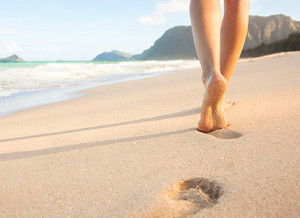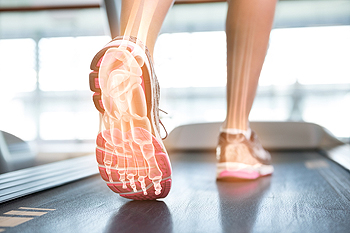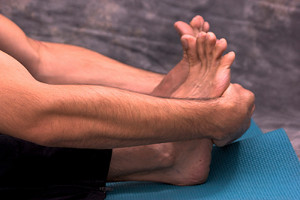 Although Emilie Reas of San Diego loves to run, there is something about her running that makes her stand out from everyone else. Reas has been able to run different marathons all while being barefoot. After discovering in 2013 that barefoot running can reduce injuries, Reas has opted to stop wearing shoes when she competes. There is a difference in biomechanics between barefoot runners compared to runners who wear sneakers. People who wear sneakers are more likely to land on the heels of their feet when they step, while barefoot runners tend to land on their forefeet.
Although Emilie Reas of San Diego loves to run, there is something about her running that makes her stand out from everyone else. Reas has been able to run different marathons all while being barefoot. After discovering in 2013 that barefoot running can reduce injuries, Reas has opted to stop wearing shoes when she competes. There is a difference in biomechanics between barefoot runners compared to runners who wear sneakers. People who wear sneakers are more likely to land on the heels of their feet when they step, while barefoot runners tend to land on their forefeet.
Barefoot running has its own share of benefits and disadvantages. If you have any concerns about your feet or ankles, contact one of our podiatrists from Carolina Foot & Ankle. Our doctors will treat your foot and ankle needs.
Barefoot Running
The Impact of Barefoot Running
The Advantages of Barefoot Running
The Drawbacks of Barefoot Running
So, what can runners do to make barefoot running safe? It’s best to make a slow transition from running shoes to barefoot running. Once the feet begin to adjust, try walking, then jogging and gradually increasing the distance. Minimalist running shoes may also be an option.
If you have any questions please feel free to contact one of one of our offices located in Huntersville Office | 16419 Northcross Dr Suite A, Huntersville, NC 28078; Mooresvillle Office | 206 Joe Knox Avenue Suite D, Mooresville, NC 28117; and Mountain Island | 10310 Couloak Drive, Charlotte, NC 28216. We offer the newest diagnostic and treatment technologies for all your foot and ankle needs.
Read more about Barefoot Running Athlete’s foot is a fungal infection that occurs between the toes. Symptoms of the condition are itchy, dry, red, scaly skin that tends to worsen in the summer when the weather is humid. The infection itself is usually contracted by walking around barefoot in public areas such as locker rooms or gym showers. Treatments for athlete’s foot come in creams, sprays, liquids, and powders, and they will help stop the fungus from growing. If you have athlete’s foot, be sure to wash your feet prior to applying the treatment to the skin and surrounding area. Also, do not apply to open wounds. Contact a podiatrist for tips on how to prevent and treat athlete's foot.
Athlete’s foot is a fungal infection that occurs between the toes. Symptoms of the condition are itchy, dry, red, scaly skin that tends to worsen in the summer when the weather is humid. The infection itself is usually contracted by walking around barefoot in public areas such as locker rooms or gym showers. Treatments for athlete’s foot come in creams, sprays, liquids, and powders, and they will help stop the fungus from growing. If you have athlete’s foot, be sure to wash your feet prior to applying the treatment to the skin and surrounding area. Also, do not apply to open wounds. Contact a podiatrist for tips on how to prevent and treat athlete's foot.
Athlete’s foot is an inconvenient condition that can be easily reduced with the proper treatment. If you have any concerns about your feet and ankles, contact one of our podiatrists from Carolina Foot & Ankle. Our doctors will treat your foot and ankle needs.
Athlete’s Foot: The Sole Story
Athlete's foot, also known as tinea pedis, can be an extremely contagious foot infection. It is commonly contracted in public changing areas and bathrooms, dormitory style living quarters, around locker rooms and public swimming pools, or anywhere your feet often come into contact with other people.
Solutions to Combat Athlete’s Foot
Athlete’s foot can cause many irritating symptoms such as dry and flaking skin, itching, and redness. Some more severe symptoms can include bleeding and cracked skin, intense itching and burning, and even pain when walking. In the worst cases, Athlete’s foot can cause blistering as well. Speak to your podiatrist for a better understanding of the different causes of Athlete’s foot, as well as help in determining which treatment options are best for you.
If you have any questions please feel free to contact one of our offices located in Huntersville Office | 16419 Northcross Dr Suite A, Huntersville, NC 28078; Mooresvillle Office | 206 Joe Knox Avenue Suite D, Mooresville, NC 28117; and Mountain Island | 10310 Couloak Drive, Charlotte, NC 28216. We offer the newest diagnostic and treatment technologies for all your foot and ankle needs.
Read more about Athlete's Foot Walking can provide several benefits to your body. Following a walking routine can help lower your risk of diseases, strengthen your heart, prevent dementia, and boost your energy levels. A good walking routine starts with having healthy feet. Fortunately, there are some tips you can follow to make sure your feet are taken care of. Prior to walking, you should make sure that you are not cutting your toenails too short. Toenails that are short may lead to ingrown toenails and pain. Another tip is to wear breathable socks. This will help prevent unpleasant odors, blisters, and rashes. Lastly, you should make sure you keep yourself hydrated in order to help avoid getting cracked feet.
Walking can provide several benefits to your body. Following a walking routine can help lower your risk of diseases, strengthen your heart, prevent dementia, and boost your energy levels. A good walking routine starts with having healthy feet. Fortunately, there are some tips you can follow to make sure your feet are taken care of. Prior to walking, you should make sure that you are not cutting your toenails too short. Toenails that are short may lead to ingrown toenails and pain. Another tip is to wear breathable socks. This will help prevent unpleasant odors, blisters, and rashes. Lastly, you should make sure you keep yourself hydrated in order to help avoid getting cracked feet.
Everyday foot care is very important to prevent infection and other foot ailments. If you need your feet checked, contact one of our podiatrists from Carolina Foot & Ankle. Our doctors can provide the care you need to keep you pain-free and on your feet.
Everyday Foot Care
Often, people take care of their bodies, face and hair more so than they do for their feet. But the feet are a very important aspect of our bodies, and one that we should pay more attention to. Without our feet, we would not be able to perform most daily tasks.
It is best to check your feet regularly to make sure there are no new bruises or cuts that you may not have noticed before. For dry feet, moisturizer can easily be a remedy and can be applied as often as necessary to the affected areas. Wearing shoes that fit well can also help you maintain good foot health, as well as making it easier to walk and do daily activities without the stress or pain of ill-fitting shoes, high heels, or even flip flops. Wearing clean socks with closed shoes is important to ensure that sweat and bacteria do not accumulate within the shoe. Clean socks help to prevent Athlete’s foot, fungi problems, bad odors, and can absorb sweat.
If you have any questions please feel free to contact one of our offices located in Huntersville Office | 16419 Northcross Dr Suite A, Huntersville, NC 28078; Mooresvillle Office | 206 Joe Knox Avenue Suite D, Mooresville, NC 28117; and Mountain Island | 10310 Couloak Drive, Charlotte, NC 28216. We offer the newest diagnostic and treatment technologies for all your foot and ankle needs.
Read more about Every Day Foot Care There are a variety of causes for poor circulation in the feet, and there are dangers that come along with having it as well. Your organs and extremities can be severely affected if there is a lack of blood supply to them. Fortunately, poor circulation may be improved through dietary modifications. One of the first signs of poor circulation that you will notice is constantly cold feet. This typically happens in the winter, when your oxygenated blood has trouble reaching your lower extremities. Swelling in the feet is also a common sign of poor circulation. This happens because your body retains water around the ankles as a response to the lack of blood. This symptom should not be ignored because it can be a sign of something much more serious.
There are a variety of causes for poor circulation in the feet, and there are dangers that come along with having it as well. Your organs and extremities can be severely affected if there is a lack of blood supply to them. Fortunately, poor circulation may be improved through dietary modifications. One of the first signs of poor circulation that you will notice is constantly cold feet. This typically happens in the winter, when your oxygenated blood has trouble reaching your lower extremities. Swelling in the feet is also a common sign of poor circulation. This happens because your body retains water around the ankles as a response to the lack of blood. This symptom should not be ignored because it can be a sign of something much more serious.
Poor circulation is a serious condition and needs immediate medical attention. If you have any concerns with poor circulation in your feet contact one of our podiatrists of Carolina Foot & Ankle. Our doctors will treat your foot and ankle needs.
Poor Circulation in the Feet
Poor blood circulation in the feet and legs is can be caused by peripheral artery disease (PAD), which is the result of a buildup of plaque in the arteries.
Plaque buildup or atherosclerosis results from excess calcium and cholesterol in the bloodstream. This can restrict the amount of blood which can flow through the arteries. Poor blood circulation in the feet and legs are sometimes caused by inflammation in the blood vessels, known as vasculitis.
Causes
Lack of oxygen and oxygen from poor blood circulation restricts muscle growth and development. It can also cause:
Those who have diabetes or smoke are at greatest risk for poor circulation, as are those who are over 50. If you have poor circulation in the feet and legs it may be caused by PAD and is important to make changes to your lifestyle in order to reduce risk of getting a heart attack or stroke. Exercise and maintaining a healthy lifestyle will dramatically improve conditions.
As always, see a podiatrist as he or she will assist in finding a regimen that suits you. A podiatrist can also prescribe you any needed medication.
If you have any questions please feel free to contact one of our offices located in Huntersville Office | 16419 Northcross Dr Suite A, Huntersville, NC 28078; Mooresvillle Office | 206 Joe Knox Avenue Suite D, Mooresville, NC 28117; and Mountain Island | 10310 Couloak Drive, Charlotte, NC 28216. We offer the newest diagnostic and treatment technologies for all your foot and ankle needs.
Read more about Causes, Symptoms, and Treatment of Poor Blood Circulation in the Feet